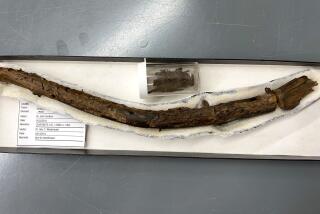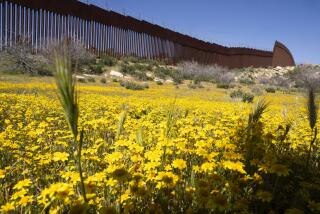Santa Cruz Island Plant Rediscovered
- Share via
SANTA CRUZ ISLAND, Calif. — A plant believed extinct for about 50 years has been discovered on this island, which is being revived as a nature preserve, a researcher said.
Researchers recently found the flowering plant, called the Santa Cruz Island rockcress, atop a rocky cliff on the island 25 miles off Santa Barbara and 100 miles northwest of Los Angeles, said Bob Hansen, manager of the Santa Cruz Island project for the Nature Conservancy, a private environmental organization.
The plant, a member of the mustard family, and specimens of other rare and endangered plants are among recent finds, he said.
Spotted on Steep Cliff
“The small population of three (rockcress) plants was spotted high on a steep, nearly inaccessible rocky cliff on the island’s north shore,” he said.
Using climbing gear to reach the site, staff members made measurements and took photographs. After comparing the new material with existing collections, an identification was made, he said.
Other finds include silver deerweed, a plant known only on Santa Cruz Island; the Santa Cruz Island lace pod and Heuchera maxima, once an important part of the island woodland ground cover, he said.
The island was almost denuded by years of excessive grazing by wild sheep, Hansen said, attributing the increase in plant life to the removal of sheep from the island.
Peregrine Falcons Sighted
In addition, two peregrine falcons, a species that has not nested on the island since the 1930s, have been seen year-round for two years. They are a male and female, but no nesting has been observed, Hansen said.
A rockcress plant was found on the island in the 1960s, but it was misidentified and its true identity was not known until now, he said.
“After taking a second look at these plants, it was determined that they were indeed Arabis hoffmannii (rockcress),” Hansen said.
Assisting in the identification was Steve Junak of the Santa Barbara Botanic Garden. He said the sheep removal program initiated by the conservancy is restoring the island to its lush state.
“Yachtsmen should see a difference on the north shore,” he said. “There is more vegetation and a greater variety. The whole island appears greener, with many other colors when flowers are in bloom.”
The Nature Conservancy manages 55,000 acres on the sparsely populated island owned by Dr. Carey Stanton, who runs a ranch there. The conservancy will eventually hold title to all of the Stanton property, which is about 90% of the island.
More to Read
Sign up for Essential California
The most important California stories and recommendations in your inbox every morning.
You may occasionally receive promotional content from the Los Angeles Times.













